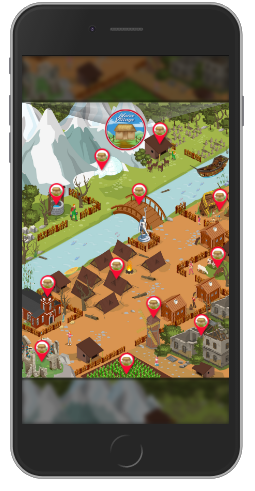Micro-learning online courses have been easily accepted by today’s millennial workforce. There are no large chunks of content to process, and it facilitates learning rather than imposing it on the learner.
To make these online courses more effective, these can be structured using one of four types of navigation systems – Course, Reference, Social and Game. Let us look at each of these in a little more detail.

1.Course Navigation
This is the traditional flow of learning management systems. The material is broken down into modules that are typically accessed sequentially. The content escalates progressively in complexity or the depth of the knowledge that is being disseminated. Modules are generally released over a period with regular intervals, and a break in the sequence would make the learning difficult to understand.

(An example of course-based navigation. Look at the index on the left where the material is broken into modules and must consumed sequentially)
Image source: QuoDeck Technologies
When to use this navigation
A course-based format of navigation is typically used when depth of learning in a subject is required.
Disadvantages of this navigation
The main disadvantage of this form of navigation is that it is designed for an academic pedagogy and doesn’t relate well to modern adult learning principles. As an example, for a micro-learning system that is being designed to train a sales team with both absolute rookies and sales veterans, the content must start with the basics of sales to cater to rookies. Sales veterans would find this initial content redundant and repetitive. Their interest in the course may wane even before they’ve even parts that are relevant to them. In the course-based format, they have no option but to plough through the initial content to get to the material that is truly relevant to them. A lot of interest loss in e-learning content happens due to this.
2. Reference Navigation
This takes a library-style approach. In this format, the learning happens because the learner is looking to learn. When the learner wants an answer to a specific question or explanation of a concept, he accesses the material organized as a collection of information nuggets with a well-structured searching system.

Image source: Hubspot
When to use this navigation
This format of navigation is best used when the learning system needs to be structured with a knowledge management approach. It is particularly applicable when there are frequent updates to the eLearning content. For example, if the organization is in an industry which is highly regulated, like banking or aviation, such a navigation style is good to have as it provides ready reference material.
Disadvantages of this navigation
The main disadvantage of the reference navigation approach is that learners must know what they need to learn before they can search for it. A lot of critical learning might fall through the cracks as a result. As an example, assume the learning management system deals with compliance training in a bank, and a new regulation prohibiting the opening of a certain type of account is released. An employee who does not know about the birthing of this regulation will not become aware of it, simply because he/she does not know to search for it. Reference Navigation based systems require strong notification mechanisms to handle this disadvantage.

3. Social Navigation
This is a navigation style based on Social Learning Theory (Bandura, 1971). According to this theory, learning is a cognitive process that takes place in a social context and can occur purely through observation or direct instruction, even in the absence of motor reproduction or direct reinforcement. In addition to the observation of behavior, learning also occurs through the observation of rewards and punishments, a process known as vicarious reinforcement. This is a knowledge management approach to eLearning design. The learners themselves participate alongside teachers in creating and growing the eLearning material.

(An example of social navigation. A learner is asking a question and experts have answered it.) Image source: Quora
When to use this navigation
A classic case of this approach is a forum where questions are debated and answered by the participants, or there’s a panel of experts who answer questions shared by participants. The now omnipresent mechanics of likes, comments and shares have created an environment where this has emerged as a powerful learning navigation method. Wikipedia, Quora and Stack Overflow are prime examples of effective social learning on a grand scale.
Disadvantages of this navigation
The main disadvantage of this approach comes from its over-reliance on participation for content creation. In an organizational setting, driving users to participate in the learning system is a difficult problem. Gamification mechanics of points, badges, leaderboards, and rewards can be used to help the cause, but designing such a gamification system requires experts, who can be expensive and difficult to find.

4. Game Navigation
This navigation style, also known as game-based learning, is unique to the micro-learning approach. In this style of navigation, the learner engages with the learning management system with the intention to play a game and any learning that happens is through the game and incidental. The learning structure in the game can span the spectrum of complexity, ranging from simple constructs like in-game quizzes and exercises to more complex formats like story-telling and learning through the game-play itself.

Image source: QuoDeck Technologies
The best example of this style, in our opinion, is the Sid Meier’s Civilization series of games. All titles in the series share similar gameplay, centred on building a civilization on a macro-scale from prehistory up to the near future. As of February 2016, the series has reached 33 million total units shipped. While the game is designed for entertainment, it provides strong insights into history, economics, political science and ecology, teaching players at a conceptual level what these evolved concepts truly signify for a society.
This method of micro-learning falls within the space of Serious Games. Serious games are simulations of real-world events or processes designed for the purpose of solving a problem. Serious games can be entertaining; however, their main purpose is to train or educate users. Serious games may also be used for other purposes, such as marketing or advertisement.
In fact, often a serious game will deliberately sacrifice fun and entertainment in order to achieve a desired progress by the player.
When to use this navigation
Given the buzz of game-based learning and gamification which started a decade ago, this navigation can be used and has been used across different types of learning, from employee induction to even more serious topics like compliance training. Engaging storylines and gameplay have proved effective in communicating learning concepts in an engaging and playful manner.
A word of caution: Avoid using this navigation for sensitive topics like POSH training or Gender Sensitization, as it may not go down well with your stakeholders as well as the audience.
Disadvantages of this navigation
The main disadvantage of game-based learning for learning lies in its very name. Games are often seen as non-serious, and therefore, meet with resistance from organizational decision makers. Also, the complexity of serious games need to maintain a very careful balance of challenge and simplicity to be effective. Creating effective microlearning games, therefore, does require game designers, apart from the technology, which can prove to be expensive.


you got a very excellent website, Gladiolus I found it through yahoo.
LikeLike